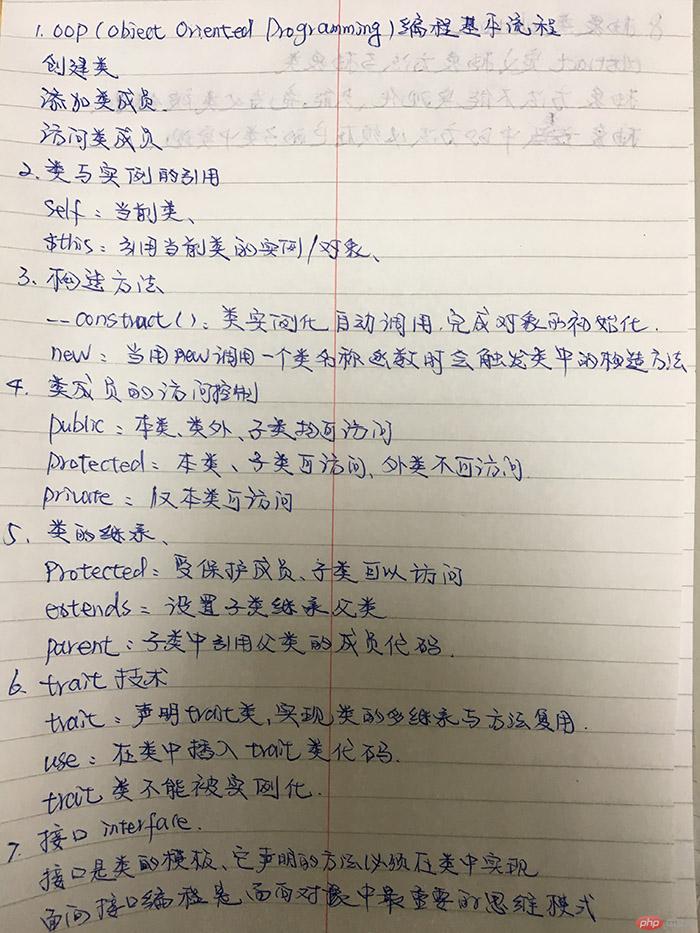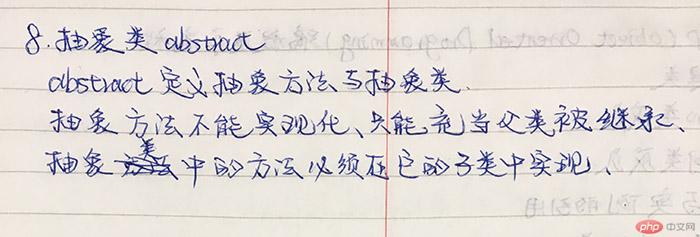一、OOP编程基本流程
// 1. 创建类class Demo1{// 2. 添加类成员// 在类中的变量和函数,和程序中的变量与函数有区别, 添加了访问限制符// 变量=>属性, 函数=>方法, 访问限制符 成员// 创建属性public $site = 'php中文网';// 创建方法: 输出当前类的属性$sitepublic function getSite(){// 第一步:类的实例化$obj = new Demo1;// 第二步: 返回类属性return $obj->site . ' 欢迎您~~';}}// 3. 访问类成员$obj = new Demo1;// 访问属性: 对象成员访问符: ->echo $obj->site . '<br>';echo $obj->getSite();
二、类与实例的引用
self: 引用当前类$this: 引用当前类的实例/对象
class Demo{private $name;private $age;public function __construct($name, $age){//$obj = new self();$this->name = $name;$this->age = $age;}public function getInfo(){return $this->name . '--' . $this->age;}}$obj = new Demo('唐僧', 30);echo $obj->getInfo(); //唐僧--30
三、构造方法
__construct(): 类实例化自动调用,完成对象的初始化new: 当用new调用一个类名称函数时会触发类中的构造方法
<?phpclass Demo{private $name;private $age;//当类被实例化,构造方法就会自动完成方法内的所有操作public function __construct($name, $age){$this->name = $name;$this->age = $age;$this->getInfo();}public function getInfo(){return $this->name.'--'.$this->age;}}echo new Demo('唐僧', 30); //唐僧--30
四、类成员的访问控制
public: 本类, 类外, 子类均可访问private: 仅本类可访问protected: 本类,子类可访问,类外不可见
class Demo{private $name;private $age;public function __construct($name, $age){$this->name = $name;$this->age = $age;}//使用成员方法来访问 私有化成员属性public function getInfo(){return $this->name.'--'.$this->age;}// 魔术方法: __get($name), 属性重载public function __get($name){// 仅允许用户名是'admin'的用户访问,其它访问返回: 无权访问$username = $_GET['username'] ?? '';if (isset($username) && $username === 'admin') {return isset($this->$name) ? $this->$name : '属性未定义';} else {return '无权访问';}}}$obj = new Demo('唐僧',30);echo $obj->getInfo(); //唐僧--30echo $obj->sex; //属性未定义
五、类的继承
protected 受保护成员,可以子类中访问extends 设置子类继承的父类parent 子类中引用父类成员代码
class Demo{public $name;public $age;public function __construct($name, $age){$this->name = $name;$this->age = $age;}}class Child extends Demo {public $sex;/*** Child constructor.* @param $sex*/public function __construct($name, $age, $sex){parent::__construct($name,$age);$this->sex = $sex;}public function getInfo(){return $this->name.'--'.$this->age.'--'.$this->sex;}}$obj = new Child('唐僧',30);echo $obj->getInfo(); //唐僧--30--男
六、接trait技术
trait 声明trait类,实现类的多继承与方法复用use 在类中插入trait类代码
trait Common{public function getInfo(){return $this->name.'--'.$this->age.'--'.$this->sex;}}class Demo{public $name;public $age;public function __construct($name, $age){$this->name = $name;$this->age = $age;}}class Child extends Demo {//使用trait技术,实现了Child类继承多累的需求use Common;public $sex;/*** Child constructor.* @param $sex*/public function __construct($name, $age, $sex){parent::__construct($name,$age);$this->sex = $sex;}}$obj = new Child('唐僧',30,'男');echo $obj->getInfo(); //唐僧--30--男
七、接口interface
interface 定义接口implements 实现接口
interface iCommon{public function hello();public function say();}class Demo implements iCommon {public $name;public $age;public function __construct($name, $age){$this->name = $name;$this->age = $age;}function hello(){return 'hello '.$this->name;}function say(){return 'say '.$this->name;}}$obj = new Demo('唐僧',30);echo $obj->hello(); //hello 唐僧echo $obj->say(); //say 唐僧
八、抽象类abstract
abstract class Common{abstract function hello();public function say(){return 'say goodbye! '.$this->name;}}class Demo extends Common {public $name;public $age;public function __construct($name, $age){$this->name = $name;$this->age = $age;}function hello(){return 'hello '.$this->name;}}$obj = new Demo('唐僧',30);echo $obj->hello(); //hello 唐僧echo $obj->say(); //say goodbye! 唐僧
手写:


THE END !

